The Uruguayan Adventure
by Bernard L. Warren
Reprinted from "Crown Jewels of the Wire", January 1995, page 5
Easter Sunday 1994 found Jim Bergman, my collector friend and golfing buddy
from Anchorage, rendezvousing with me at Miami International Airport in Florida.
Jim had flown down from Anchorage while I made the drive down from Virginia and
met his plane. Our nonstop, overnight flight from Miami to Buenos Aires was
uneventful and, after a plane change and a short flight over the Rio De La
Plata, we found ourselves landing at Montevideo, the capital of Uruguay.
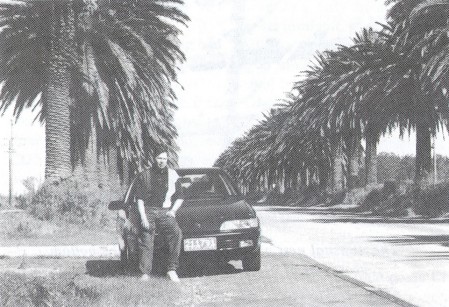
Jim Bergman, our rental car and an avenue of date palms.
This trip had been carefully researched and planned for three years. After
four very extensive and enjoyable insulator research trips to Australia and a
short trip to Europe, this writer had decided that the next insulator research
trip must be to South America. Three factors helped make the selection of
Uruguay for this trip an easy one. First, they had a democratic government and a
very low crime rate. This fact, plus having Jim with me the entire time, greatly
lessened my wife's concerns about the trip. Second, the fact that two glass
companies were known to have produced insulators in several styles and colors.
And third, the country was small. At roughly 300 x 300 miles, it could be
completely covered and researched in two plus weeks.
After clearing customs and picking up our rental car, we suddenly found
ourselves touring the outskirts of Montevideo, a sprawling metropolis of 1.5
million people, one-half the population of all Uruguay. Observing the tops of
all utility poles became an instant avocation for both of us. It didnít take
long to decide that the vast majority of Uruguayan insulators were porcelain, a
fact born out during our two plus weeks of touring.
Late that evening, we spotted nine CD 128ís on telephone lines leading into
a large industrial complex. All were the gorgeous, deep green colors but close
inspection with binoculars revealed that most had wire groove chipping, a
problem common to the CD 128ís due to the sharp edge of the upper wire groove
rim. This proved to be one of only three places in the entire country that we
saw a few of the rare CD 128ís in use. We admired them and continued on.
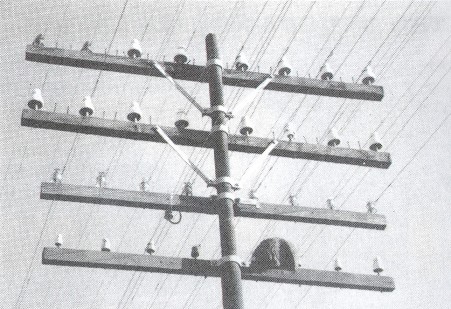
The unusual nest of the Bower bird on the bottom
Crossarm of a four crossarm metal pole.
(Authorís note - as guests in a foreign country, all of our insulators were
obtained by buying them, having them given to us or finding them where they had
been tossed or left on the ground.)
Our next day of touring had two memorable highlights. One was coming across a
crew of three power company linesmen and convincing them to give us three deep
straw, unembossed CD 513ís on two poles they were working on, our first CD 513ís.
The second highlight was getting permission from a telephone linesman to go
through his large ďjunk boxĒ, filled mostly with metal pins and an
assortment of porcelain and glass insulators. A few nice insulators were
salvaged from the box but something urged me to keep scratching. A small
porcelain spool appeared in the very bottom layer of trash, or was it porcelain?
Some quick cleaning showed it to be a deep olive green CD 1051 spool, the only
glass spool found on our trip and the second CD 1051 currently known in a
collection.
Uruguay's railroad lines were a big disappointment to us. Many were built
around 1900 by British companies and they were uniformly equipped with Cordeaux
style porcelain or composition insulators. Not a single glass insulator was ever
observed on the railroad signal lines throughout Uruguay.
The search for a CD 388, Uruguay's only medium large power insulator, was a
real battle. Although four mint and two damaged units were eventually located in
a storage shed, not one CD 388 was ever seen in service and it is doubtful if
any are still in use.
A real disappointment for us was not finding, or even seeing, a single CD 560
or CD 1052 on our entire trip. Although three deep violet cobalt CD 560ís
exist in collections in the U.S., along with one unembossed light green CD 560,
they appear to be a non-existent item in Uruguay. The same is true of the CD
1052 spool in 7-up green, two of which are known to exist in U.S. collections.
We spent several hours chasing rumors of an employee having one of these spools
in one city, only to end up empty handed. Again, not a single CD 1052 specimen
was ever seen in the country.
One thing that was seen in one part of the country was snakes. Four very
lively (and most likely poisonous) snakes were encountered in a two hour period
one day. For the next day or so, this sharply curtailed our habit of stomping
around in high grass in tennis shoes while looking for insulators along former
line right-of-ways. Fortunately, we never saw another live snake.
Early during our second week, we came across eight or so poles with crossarms
and insulators, but no wires, that had been left on the ground alongside the
highway. The poles appeared to have been on the ground a couple of years or more
as bushes were growing up between the crossarms. While retrieving some tiny
Argentine porcelains and some amber and green CD 501.1ís, I spotted a
different colored 501.1. Removed from the peg and held up to the light, it
proved to be a deep olive green, a fabulous new color. We had found several new
colors and new embossings by this time (more on that next month) but the olive
green finds were very special and very rare. After whooping it up a bit and
sharing the find with Jim, we drove forward four more poles where Jim
immediately found another olive green 501.1 on the first pole he checked. There
were no more, of course, but the thrill that Jim and I shared in each finding
his own rich olive green CD 501.1 was a special experience and another highlight
of our trip.
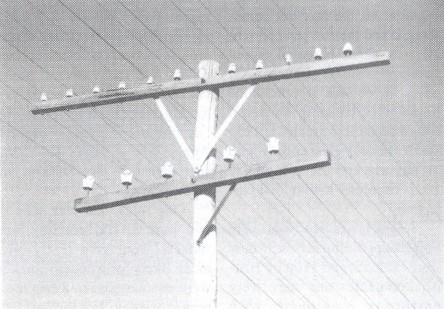
A row of French porcelain gingerbread
"boys" on early 1900's lines.
One of the big surprises we received was passing two crossarms of white
porcelain gingerbread men while speeding down a major highway. We turned around,
drove back and took pictures to confirm what we had seen. Local authorities told
us this line was almost one hundred years old and the French gingerbread
insulators were thought to be original equipment on it. Fortunately, they had
two nice specimens to share with us.
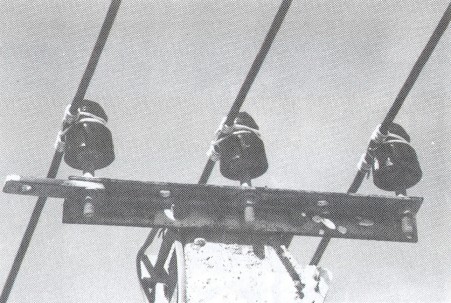
Dark amber CD 503's on power lines.
Another time, we received permission from the manager of a salvage yard to
check out a pile of junked hardware, insulators and trash behind the offices.
She and her assistant even went with us and helped in the search. Less than five
minutes into the search, I found the complete skirt of a deep olive green CD 502
with the whole dome popped off at the wire groove and missing. My excitement was
instantaneous and five more minutes of frantic digging uncovered the missing
olive dome. When the two pieces were put together correctly, not a sliver of
glass was missing and the break was nearly invisible. The two ladies just
laughed and shook their heads at the exuberance of those crazy Norte Amexicanos
over one insulator, especially a broken one. The deep olive CD 502 is one of my
favorite insulators from the trip and finding it, with the assistance of Jim and
the two gracious ladies, was one of the most memorable experiences.
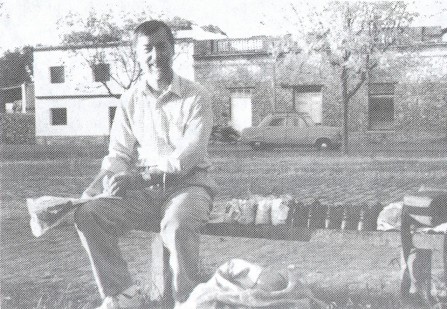
(Above) Bernie wrapping insulators on a park bench while Jim
uses a table to sort and wrap in a part bordering
the Rio De La Playa (below).
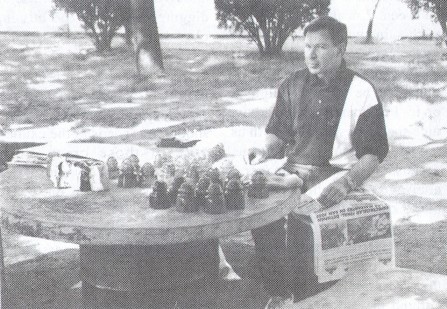
Another special experience and real highlight was in finally meeting and
spending part of two weekends visiting with Jose Luis Rubio of Montevideo, a
former insulator collector. I had corresponded with Jose a couple of times prior
to our trip and his friendship, suggestions, information and assistance were of
immeasurable help to us.
The existence of the huge Montevideo Flea Market was one of the gems Jose
shared with us. We spent three plus hours at it our last Sunday and were able to
race through perhaps one half of it. Some of our finds were deep 7-up green
embossed milk bottles; whittled, thick glass, deep cobalt blue, wide mouth jars;
small amber Montevideo embossed medicines, made by Whitall Tatum; antique
license plates; old glass company stock certificates and a myriad of other gems.
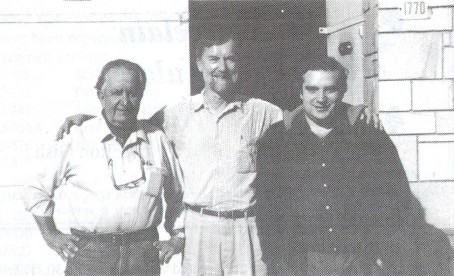
Jose Luis Rubio, Bernie and friend in Montevideo
Jose was also responsible for arranging our last night visit with Gus and
Martha Coll, another lovely couple from Montevideo. Gus collects glass and
porcelain insulators and Martha collects antique bottles. Gus also has a special
interest in early telegraph equipment and has a beautiful collection of pieces
he has acquired and painstakingly rebuilt and refinished to like new condition
and luster.
All good things must eventually end and so it was with our Uruguayan
Adventure. We climbed into the friendly skies of United for our short flight
back over the Rio De La Plata to Buenos Aires, then switched to Unitedís
non-stop, over-night, 747 service back to Miami.
Adios Uruguaya!
| 